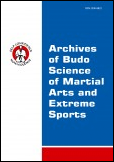2018, Volume 14, Issue 1
Morphofunctional characterization of male Marajoara wrestlers
ĂŤtalo SĂ©rgio Campos1, CLAUDIO JOAQUIM BORBA-PINHEIRO2, Amauri Gouveia1
1Neurosciences and Biology, Center for Studies and Research in Combat Sports (NEPLEC) of the Federal University of Pará (UFPA) Belém, Pará state, Brazil, Belém, Brazil
2Physical Activity and Health, Center for Studies and Research in Combat Sports (NEPLEC) of the Federal University of Pará (UFPA) BelĂ©m, Pará state, Brazil, TucuruĂ, Brazil
Author for correspondence: CLAUDIO JOAQUIM BORBA-PINHEIRO; Physical Activity and Health, Center for Studies and Research in Combat Sports (NEPLEC) of the Federal University of Pará (UFPA) BelĂ©m, Pará state, Brazil, TucuruĂ, Brazil; email: claudioborba18@gmail.com
Full text
Abstract
Background & Study Aim: Marajoara Wrestling is widely practiced in the Marajó Archipelago (Northern Pará state, Brazil), but still little known in the combat sport milieu. The aim of this study was the knowledge about anthropometric data, motor aspects and correlation variables of Marajoara wrestlers, and also establishing possible performance indicators that can characterize this modality.
Material & Methods: The sample consisted of eight competitive male athletes, aged between 23 and 53 years. The data were analyzed using Pearson’s linear correlation, the Shapiro-Wilk test and a significance level of p<0.05.
Results: Based on the results, the following can be concluded: 1) isometric hand grip strength (HGS) and thoracolumbar flexibility are strong indicators of performance; 2) Marajoara wrestlers exhibit much higher isometric hand grip strength when compared with athletes from other grappling sports; 3) there is a strong statistical relationship between isometric hand grip strength and thoracolumbar flexibility.
Conclusions: It is believed that this information will be incorporated into Marajoara Wrestling training programs. Furthermore, wrestlers, sports organizations and traditional Marajó Archipelago populations should benefit from the information reported here, considering the growing concern with “sportifying” the modality and its national and international recognition in the world of combat sports.
Key words: technique, performance, grappling sports, combat sports, traditional wrestling





